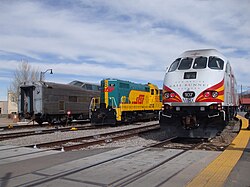Santa Fe Southern Railway

Santa Fe Depot, with a Rail Runner Express train (right), alongside a diesel locomotive and ex-Santa Fe Pleasure Dome operated by the SFSR
|
|
| Reporting mark | SFSR |
|---|---|
| Locale | Santa Fe County, New Mexico, USA |
| Dates of operation | 1992–2014 |
| Track gauge | 1,435 mm (4 ft 8 1⁄2 in) |
| Santa Fe Southern Railway | ||||||||||||||||||||||||||||||||||||||||||||||||||||||||
|---|---|---|---|---|---|---|---|---|---|---|---|---|---|---|---|---|---|---|---|---|---|---|---|---|---|---|---|---|---|---|---|---|---|---|---|---|---|---|---|---|---|---|---|---|---|---|---|---|---|---|---|---|---|---|---|---|
|
||||||||||||||||||||||||||||||||||||||||||||||||||||||||
The Santa Fe Southern Railway (reporting mark SFSR) was a short line railroad in New Mexico, United States. In addition to carrying freight, it also operated as a tourist railroad that carried passengers between Lamy and Santa Fe, a distance of 18.1 miles (29.1 km).
The Santa Fe Southern began operations in 1992, after the Atchison, Topeka and Santa Fe Railway ended operations on their Lamy to Santa Fe line and a group of local businesspeople purchased the track to continue freight service in the area. Passenger service was added later on.
On October 8, 2010, the railroad was purchased by STI-Global, Ltd., an Australian-based company. STI-Global said that the purchase would allow it to test the safety systems the company produces.
On May 20, 2011, the railroad was evicted from its headquarters at the depot in Santa Fe to make way for a new visitors' center planned to serve New Mexico Rail Runner passengers.
On August 12, 2012, the railroad was featured in the AMC TV series Breaking Bad season 5 episode "Dead Freight", in which one of the railroad's locomotives was delayed at a highway crossing in order to facilitate theft of 1,000 gallons of the industrial chemical methylamine from a tank car near the end of the train. In the credits, special thanks were given to the railroad for making the episode possible.
The railroad's business fluctuated greatly; in 2004, it hauled 401 carloads of freight, and in 2007 carried 25,907 passengers, but in 2009 these counts decreased to 25 and 12,208, both record lows. Towards the end of its existence, the railroad changed from separate freight and passenger operations to mixed trains (which carry both freight and passengers) at least twice a week, depending on the season. The railroad also offered charter and special trains.
...
Wikipedia
